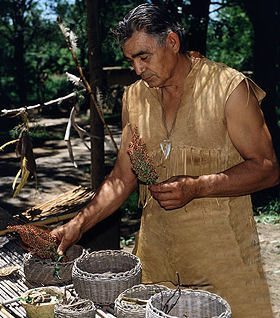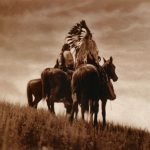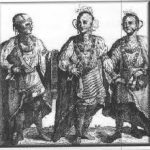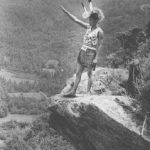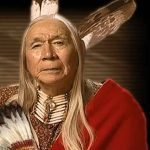Magic In Cherokee Life
For well over a hundred years the Oklahoma Cherokees have been writing down their magic by means of the Sequoyah syllabary in manuscript books that vary in size from tiny pocket notebooks to huge ledgers, and upon odd scraps of paper. We have seen it upon requisition forms of the union army, upon the back of a calendar, upon coarse wrapping paper and cardboard torn from boxes, and in the white spaces of a letter from President U.S. Grant’s secretary of the interior.
Both magic and medicine are almost certain to be found commingled in a manuscript that the Cherokees refer to by the general term nvwodhi digohwe:li (“medicine book or [papers]”), but also to be seen there are such typical oddments as family demography, scriptural references and extracts, drafts of letters, addresses, grocery lists in Sequoyan and phonetic English, and a considerable amount of mathematical doodling, for which the Cherokees have a passion that long ago ought to have attracted competent psychological investigation. Side by side with an incantation to discomfit a demon may be a set of figures that attest to the comforting fact that the Lord’s work is prospering in the Baptist church nearby.
Any layman may decide to preserve in writing that magic for which he has use and which is readily available to his social class: fishing charms, a little something to protect him in an emergency, and the like. The medicine man, whom the Cherokees call didahnvwisgi (“curer of them”), may possess a small library of manuscripts. Even the didahnesesgi (“putter in and drawer out of them”)- a sorcerer, a “witch”- may risk writing down his criminal arcana. The literary motivation of them all is the same: magical sayings abound in archaisms, ritualisms, and tricky wording, and they are hard to remember.
If it is exceedingly difficult for one without proper credentials to acquire a “medicine” manuscript of any kind, even one that deals with treating the toothache, the obstacles to be overcome in obtaining one that gives precise instructions as to how to separate a married couple or to befuddle a jury can well be imagined. Since he is more than likely to be Christian, the layman has no desire for the rumor to reach his congregation that he is doing a little weekday witching, and he is apt to deny having any knowledge whatever of magic. The medicine man is disinclined to discuss the secrets of his profession with anyone except another medicine man, from whom he stands to learn something. And, needless to say, no didahnesesgi wants to confess to being what he is.
The majority of Cherokees profess Christianity, and the attitude of that majority is essentially inimical toward the ancient tribal magic, although it is not antagonistic toward the old medicine. The dividing line between the two areas is, of course, largely determined by individual interpretation. The average Cherokee is unable to see any inconsistency in his willingness to permit invocation of a specific bird or animal spirit for the curing of his liver and his abhorrence of having the same spirit petitioned to achieve revenge upon a personal enemy. In his opinion, a well Christian is of more worth to the Kingdom Of God than a sick one, and since he is apt to hold jaundiced views on the white man’s therapeutic prowess, he feels it is his duty to avail himself of the most effective healing techniques of which he knows. But vengeance belongs to the Lord.
All magic, of course, is not considered to be of uniformly sable hue. There is a certain air of legitimacy about magical measures taken to protect one from evil or to prevent something evil from happening. And here again we deal with individual interpretations. One person who sees no harm in using a charm to protect himself while traveling is utterly scandalized to learn that his neighbor, at present without a wife, is dabbling in love magic in order to repair the deficiency. And secure in his Christian rectitude, that neighbor is appalled to find out that a deacon, no less, in the community church did not commit the outcome of a recent lawsuit entirely to the acumen of lawyers.
Some magical practices are condemned by Christians and pagans alike. Sorcery to make a person ill, or to separate a man and his wife is universally abhorred and feared.
The Magical Incantation
“Most Cherokee magical rituals consist of something that one says (or merely thinks) or sings, called the igawesdi (to say one), and some recommended physical procedures, called the igvnedhi (to do one), although some have no igvnedhi at all. The published literature on Cherokee magic does not recognize a fundamental truth: In any magical ritual all generative power resides in thought, and the igawesdi, which focuses and directs that thought, alone is inviolate. The igvnedhi, which merely augments the authority of thought, or serves more effectively to apply and disseminate it, may be expanded, curtailed, altered, or dispensed with entirely in conformity with personal preference, special circumstances, or the broad general principles that govern Cherokee medico-religious practice.
“There are striking parallels between Cherokee magical ritual and the Roman Catholic Mass. An igawesdi may have it’s ordinary and proper aspects, and just as we have the Missa solemnis and the Missa lecta, so do we have Cherokee texts that may optionally be sung or spoken. And while it is true that the Cherokee shaman is no more at liberty to alter phraseology than is the celebrant of the Eucharist, certain interpolations, analogous to the tropes of the Middle Ages, are admissible.
“Most commonly these extraneous elements take the form of th repetition of a key word the sacred four times; the interjection of the supremely sacrosanct numeral seven; the insertion of the pronoun ayv (“I”); and a hiatus in which the reciter thinks intently upon the purpose of the ritual. These are not introduced with complete freedom, but only at certain junctures approved by custom, and they are usually indicated in manuscript texts by symbols- crosses, numerals, a series of vertical dashes, and the like.
“From the published literature one might get the impression that a particular igawesdi is usable for but one highly specific purpose, whereas in actuality any igawesdi is serviceable for any number of purposes for which it’s wording qualifies it.” what is more, a master didahnvwisgi is at perfect liberty to improvise a text if the spirit moves him to do so. A text that has descended to him through tradition he will not knowingly alter, though he may not fully understand what he is saying, but upon occasion he may elect to use only part of it.
While in terms of sheer quantity the idigawesdi that are used for curing very greatly outnumber those of an essentially magical nature, nevertheless there exists an impressive corpus of the latter, and formerly there must have been a truly astonishing number of them. The scope of Cherokee magic has been imperfectly perceived in the published literature. While we present here many areas of magical practice that have not been previously reported, to our certain knowledge this study is far from exhaustive.
If there is idigawesdi for luck, then maybe visit our friends at Americas Cardroom! Play games, bet on sports, and join one of the largest online poker rooms all from Americas Cardroom. Redeem the Americas Cardroom promo code WELCOME100 and get up to a $1,000 bonus. Click here to learn more.
The Magical Ritual
The chief vehicle for disseminating the power of thought is tobacco, both the commercial variety and Nicotiana Rustica. Nowadays, the former is usually purchased in stores. Twist and plug forms of it are usually preferred, although in a circumstance where the tobacco is to be smoked by a woman or a physically weak man, finely cut pipe tobacco may be used because it has less nicotine content and is more palatably adulterated than either twist or plug. Up until a generation or so ago the Cherokees grew a good deal of commercial tobacco of rather high quality which, after being worked up into twists and plugs, they smoked and chewed for pleasure, as well as used ceremonially. They grow little of it today.
Nicotiana rustica, which they usually call tsolagayvli (“tobacco, ancient”), was never raised extensively in Oklahoma, and in these days it is exceedingly scarce. Since among the Western Cherokees it is used with very great infrequency in healing, and in magic most commonly for nefarious purposes, it is no easy matter to get an upstanding didahnvwisgi to confess that he possesses any of it, or even admit that he knows where it might be obtained.
Tsolagayvli is not planted in a field, as is commercial tobacco; for if anyone other than the planter should see it while it is growing, its power is vitiated. It is raised in secrecy in the woods, under conditions duplicating as nearly as possible a wild state. The seeds are planted on Christmas day or St. Valentines day in a small patch of ground prepared by having lightning struck wood burned upon it. The occurrence of Thunder on the day of its planting is considered to be an especially good omen.
Since Tsolagayvli is both very hard to come by and overwhelmingly puissant, only a minute pinch of it is generally used for any purpose. It is almost never used alone.
Tobacco has no inherent magical powers, although it possesses curative properties. it must be godhlvhisohnvhi (“remade,it”)- that is, infused with supernatural authority- before it can be used magically.
The principle factor in “remaking” tobacco is the saying (or thinking) or singing of a text over it; for this transfers the creative thought to the inert herb. The potential power of the tobacco, already magical now that it has been endowed with the generative force of the human mind, can be enhanced by strengthening measures that are not absolutely necessary for the accomplishment of the purpose for which the tobacco was “remade,” but which do serve to achieve the desired end more quickly.
Dawn is held to be the juncture in day when the division between the natural and the supernatural is the most indistinct, and the projection of mundane energy into the spiritual realm most easily accomplished. Tobacco is usually “remade” at this time. In certain circumstances, rather consistently for evil purposes, the negating and de-energizing influences of dusk or midnight are desirable.
In order to take advantage of the enormous generative power of running water, the bank of a stream is the most advantageous place for “working,” although some conjurors prefer to perform at a spring. There are ceremonies for which rippling or bubbling water is considered to be especially desirable. Divining rites, for practical reasons, require the water to be still. there are some magical rituals, usually of a minor nature, which are seldom enacted by water. But if a large issue is at stake, the magician does not merely “work” beside water, but also washes with it, throws it over his head, or bathes in it.
If the ceremony is performed at dawn, the celebrant almost invariably faces east, the sacred and success-giving direction. In some cases, after the tobacco has been “remade” by the igawesdi, it is held up to the strengthening rays of the rising sun. This is never done, at least by a master of his craft, if the tobacco is to be used for a sinister purpose.
While certain idigawesdi are traditionally delivered but once, most of the texts utilized in “remaking” tobacco are reiterated for a total of four times. In some rare instances, seven times is the recommended number. Ordinarily a single mornings “working” is considered to be sufficient, yet one discovers examples in which the prescription is for four ceremonies per day, or a set of enactments for four or seven successive days. The latter types sometimes present problems to the magician if the weather must be fair in order to achieve best results, as is frequently the case. If he encounters a cloudy morning in his series, he must begin anew.
As has been correctly stated in the published literature, the saliva of an individual contains the very essence of his life force and personality, but to a lesser degree so does his breath. Expectorating and blowing upon the tobacco, therefore, invest it with strength from the life and being of the magician. And, incidentally, the magician must be in perfect health for his magic to have any efficacy.
While an idigawesdi is being said over it, the tobacco is customarily held in the left hand and kneaded with a counter-clockwise rolling motion of the four fingers of the right hand. For any circling movement counter-clockwise is the “successful” or fortunate direction. In analogy to tobacco’s being “remade” at sundown or midnight and not dawn, the rolling is sometimes clockwise.
It is rather general practice for the magician to be fasting while “remaking” tobacco, But if he abstains from food all the rest of the day, the force of the magic is enormously fortified.
If the tobacco that is used contains an admixture of tsolagayvli, it is neither blown nor held up to the rays of the sun. Cedar leaves or cedar seeds are occasionally added to tobacco that is “remade” for use in repelling witches, and in addition, shredded grapevine to that prepared for the purpose of capturing the affections of a woman.
A cigarette or cigar can be “remade” with as much success as plug, twist, or cut pipe tobacco. One has to omit the counterclockwise rolling motion used when delivering the igawesdi, and when the cigarette or cigar is blown, two successive puffs of air are bestowed upon the one end, two upon the other. Snuff, being too easily airborne, is never “remade”.
All “remade” tobacco is exceedingly sensitive to the malign influences emanating from a menstrual or pregnant woman, a dead person, or someone who has been in contact with a corpse, and it can be weakened or rendered impotent by its merely being in the same house with them. Actual contact is not necessary. Its power is broken if it is smoked by anyone other than the person who “remade” it or the person for whom it was prepared.
In situations of critical importance a didahnvwisgi may elect to turn over the task of “remaking” tobacco to those comely and benign spirit midgets, the yvwitsunasdii (“people/small,they”-Little People). The tobacco is left in the vicinity of where these beings are known to reside, usually rocky or craggy places, and the individual who placed it there is informed that the “remaking” has been accomplished by discovering that it has been moved from its original location.
“Remade” tobacco is customarily used in one of four ways: it is smoked in such proximity to the individual who is its target that the smoke actually touches that person; its smoke, sometimes on a set schedule, is merely projected towards the victim, or the direction in which he is likely to be; it is smoked in such a fashion that its fumes pervade a general area; it is not smoked, but instead is placed where the person for whom it is intended comes into contact with it.
Spirits And Color Symbolism
The spirits in Cherokee magic are invoked with logic, even though the premises upon which it is predicated are not always extant. Many of the basis for attributing certain powers to these spirits undoubtedly derive from lost myths. For example, there is a myth that apparently has been written nowhere except in the field notes of Frans M. Olbrechts that sheds light upon the authority attributed to the Kingfisher. But it is obvious why protection-magic petitions the assistance of Thunder, Lightning, various fierce serpents, and the Mountain Lion, and why the lover, seeking to make himself attractive, wishes to acquire the attributes of the Redbird and those dazzling spirit birds, the Tsugvtsalala and the Disdi. As might be expected, some of the spirits that are stellar in Cherokee magic appear seldom, if at all, in Cherokee medicine.
The color symbolism that we discover in both the magic and the medicine is exceedingly subtle. In a broad sense colors are affiliated with directions and stylized attributes, but the incantor applies his colors (which are seven) like a painter in order to produce a total impression, and with his palette he can make a thought painting gradually glow, or fade into sepulchral and sinister purples, blues, and blacks. Through colors he achieves dramatic development.
Much of the vaulting nobility of the phraseology of the magical idigawesdi appears to transfer in translation, but the passionate life that throbs through those long and sinuous verb-forms that leap upon and joyously wrap themselves around raw thought-material that emerges timidly from the mind is little in evidence. The masters of the Cherokee language who conceived the magical idigawesdi created like great composers with elements of demonic force, surpassing plasticity. What in English are dreary little walls of word-bricks, “the Seven Clans”, “not to climb over me” and the like, in Cherokee are sheer soarings of the human spirit, infinitely varied.
One can well understand why a magical igawesdi, if not delivered in the language in which it was created, is devoid of all power of enchantment.

